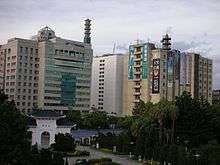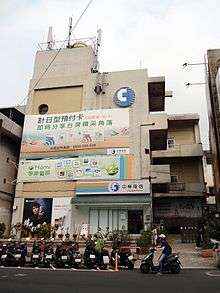Chunghwa Telecom
Chunghwa Telecom Company, Ltd. (Chinese: 中華電信; pinyin: Zhōnghuá Diànxìn; Wade–Giles: Chung1-hua² Tien4-hsin4) (TWSE: 2412, NYSE: CHT) is the largest telecommunications company in the Republic of China (Taiwan) and the incumbent local exchange carrier of PSTN, Mobile, and broadband services in the country.
 | |
Native name | see below |
|---|---|
| Public | |
| Traded as | TWSE: 2412 NYSE: CHT |
| Industry | Telecommunications |
| Founded | June 15, 1996 |
| Headquarters | Zhongzheng, Taipei, Taiwan |
Key people | Yu Cheng, chairman and chief executive officer |
| Products | Mobile Internet Fixed Network |
| Revenue | USD 7.300 billion (March 2016) |
| Total assets | |
| Owner | Ministry of Transportation and Communications (35.29%) |
Number of employees | 22,913 (as of 31 May 2016) |
| Website | Chunghwa Telecom |
| Chunghwa Telecom Co., Ltd. | |||||||||||||
|---|---|---|---|---|---|---|---|---|---|---|---|---|---|
| Simplified Chinese | 中华电信股份有限公司 | ||||||||||||
| Traditional Chinese | 中華電信股份有限公司 | ||||||||||||
| |||||||||||||
| China Telecom | |||||||||||||
| Simplified Chinese | 中华电信 | ||||||||||||
| Traditional Chinese | 中華電信 | ||||||||||||
| |||||||||||||


History
Chunghwa Telecom was founded as a company on June 15th, 1996 as part of the Taiwanese government's privatization efforts. Prior to this, it was operated as a business unit of the Directorate General of Telecommunications (zh:交通部電信總局) for over 100 years.
The company's common shares have been listed on the Taiwan Stock Exchange under the number “2412” since October 2000, and its ADSs have been listed on the New York Stock Exchange under the symbol “CHT” since July 2003.
In August 2005, Chunghwa Telecom became a privatized company, as the Taiwan government's ownership was reduced to less than 50%.
The Directorate General of Telecommunications once exercised a monopoly on the telecommunications market in Taiwan. To make the telecommunications industry more competitive and improve service quality, the Ministry of Transportation and Communications began to promote "telecommunications liberalization" policy from the late 1980s, in which the telecom industry would gradually be opened to private industry operations. The liberalization of telecommunications, as well as the management and operation of telecommunications business as mentioned in the plan, aimed to achieve "separation between government and enterprises".
On July 1st, 1996, the "Chunghwa Telecom Ordinance" was enacted under an amendment of the "Telecommunications Act", which formally established Chunghwa Telecom Co. Ltd. with a capital of NT$96.477 billion yuan, operating first class and second class telecom services, under the "Taiwan Northern Telecom Branch", "Central Taiwan telecommunications branch", "Southern Taiwan telecommunications branch"," long-distance and mobile communications branch", "International Telecommunication Branch", "Data Communications Branch", "Telecommunications Research Institute" and "Telecommunications Training Institute".
In 1997, Chunghwa Telecom was awarded the license to operate a second-generation mobile communications (2G) network (GSM 900 MHz and 1800 MHz).
In October 2000, Chunghwa Telecom was listed on the Taiwan Stock Exchange under the ticker symbol "2412." In July 2003, Chunghwa Telecom was listed on the New York Stock Exchange under the symbol "CHT" and on 12 August 2005, the Government of China Telecom's stake to 50%, and officially became a private company.
In 2007, Chunghwa Telecom acquired Senao International, and Senao becomes the exclusive sales agent of Chunghwa Telecom mobile phones.
On May 1, 2007, Chunghwa Telecom set up a division for enterprise customers, incorporated in the Southern Taiwan telecommunications branch.
On October 30, 2013, Chunghwa Telecom acquired in an auction for NT$39.075 billion a spectrum of LTE bands (900 MHz B2 / 1800 MHz C2 / C5), with a bandwidth limit of 2x35MHz, as well as C5-band (1800 MHz).
On May 29, 2014, Chunghwa Telecom held a press conference to announce the start of LTE services on 30 May 2014, and this made Chunghwa Telecom the first telco in Taiwan to provide LTE services.
Mobile Network Information
| Frequency | Technology Type | Band | Bandwidth | Attributes |
|---|---|---|---|---|
| 2100 MHz | LTE-A, HSPA+ | 1 | 2x20 MHz | UMTS/WCDMA service was terminated on this frequency on DEC,31,2018. After that date, this frequency was refarmed to LTE. |
| 900 MHz | LTE-A | 8 | 2x10 MHz | This frequency is to provide supplemental coverage in areas where the 1800 MHz or 2600 MHz frequencies are weak or non-existent. (Better in-building penetration). |
| 1800 MHz | LTE-A | 3 | 2x10 MHz + 2x15 MHz |
Main LTE band for most services. |
| 2600 MHz | LTE-A | 7 | 2x20 MHz + 2x10 MHz |
Supplemental network capacity in certain areas (e.g., Taipei) where network congestion may occur. |
| 3.5 GHz | NR | n78 | 90 MHz | Deployment in progress. |
| 28 GHz | NR | n260 | 600 MHz | Recently won during a spectrum auction on early 2020. |
Services
Chunghwa Telecom is the largest telecommunication service provider in Taiwan and one of the largest in Asia in terms of revenue. In terms of both revenue and customers, Chunghwa is Taiwan's largest provider of fixed line services, mobile services, broadband access service, and Internet service. The company also provides information and communication technology services to corporate customers.
HiNet has been heavily criticized for being a haven of email spammers, which has resulted in many Internet service providers routinely blocking e-mails originating from the service.[1][2][3]
Subsidiaries
Senao International, a cellular phone distributor from which Senao Networks, manufacturer of data networking products and wireless telephones under the EnGenius and Senao brands was spun off.[4]
See also
References
| Wikimedia Commons has media related to Chunghwa Telecom. |
- "Taiwan email problems due to spam". Green Internet Society. Archived from the original on 5 July 2008. Retrieved 14 July 2008.
- "Hinet Spammer/Hacker IPs". Spacequad AntiSpam Services. Archived from the original on 18 June 2008. Retrieved 14 July 2008.
- The Spamcop reporting service, as of 14 July 2008 listed HiNet as the top target domain of spam reports through its system; see "Domain Summary". Retrieved 6 December 2010.
- "Senao". Archived from the original on 8 December 2014. Retrieved 13 May 2014.